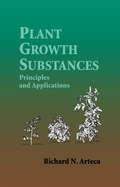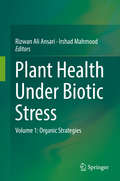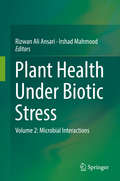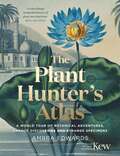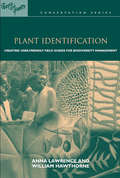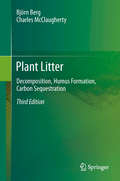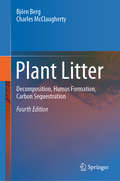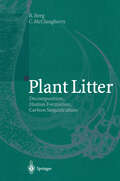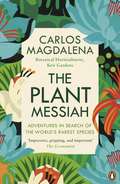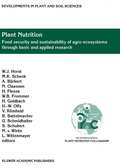- Table View
- List View
Plant Genomics and Climate Change
by David Edwards Jacqueline BatleyThis book explores the impact of climate change on agriculture and our future ability to produce the crops which are the foundation of the human diet. Specifically, individual chapters explore the potential for genomics assisted breeding of improved crops with greater yield and tolerance to the stresses associated with predicted climate change scenarios. Given the clear and unmet challenge to mitigate climate changing events, this book will be of wide interest from plant breeders and environmental scientists, government bodies through to a more general audience who are interested in the likely impact of climate change on agriculture.
Plant Geography (Routledge Revivals)
by Martin KellmanOriginally published in 1975 and in a second edition in 1980, Plant Geography was the first text in biogeography that provided an adequate treatment of modern plant population theory. It is an introduction to the subject for students of both geography and biology. The author develops a series of plant geographic concepts that are based primarily in plant population biology, treating in turn processes that operate at the level of the individual plant and the plant population; interactions between plant populations; environmental conditions and plant dissemination in shaping plant species’ distributions, and the geography of vegetation. Emphasis throughout is placed upon the dynamic nature of the earth’s plant cover, and the interplay between contemporary conditions and historical events in shaping plant distributions and evolution.
Plant Geography (Routledge Revivals)
by Martin KellmanOriginally published in 1975 and in a second edition in 1980, Plant Geography was the first text in biogeography that provided an adequate treatment of modern plant population theory. It is an introduction to the subject for students of both geography and biology. The author develops a series of plant geographic concepts that are based primarily in plant population biology, treating in turn processes that operate at the level of the individual plant and the plant population; interactions between plant populations; environmental conditions and plant dissemination in shaping plant species’ distributions, and the geography of vegetation. Emphasis throughout is placed upon the dynamic nature of the earth’s plant cover, and the interplay between contemporary conditions and historical events in shaping plant distributions and evolution.
Plant Geography of Chile (Plant and Vegetation #5)
by Andres Moreira-MunozThe first and so far only Plant Geography of Chile was written about 100 years ago, since when many things have changed: plants have been renamed and reclassified; taxonomy and systematics have experienced deep changes as have biology, geography, and biogeography. The time is therefore ripe for a new look at Chile’s plants and their distribution.Focusing on three key issues – botany/systematics, geography and biogeographical analysis – this book presents a thoroughly updated synthesis both of Chilean plant geography and of the different approaches to studying it. Because of its range – from the neotropics to the temperate sub-Antarctic – Chile’s flora provides a critical insight into evolutionary patterns, particularly in relation to the distribution along the latitudinal profiles and the global geographical relationships of the country’s genera. The consequences of these relations for the evolution of the Chilean Flora are discussed.This book will provide a valuable resource for both graduate students and researchers in botany, plant taxonomy and systematics, biogeography, evolutionary biology and plant conservation.
Plant Growth Substances: Principles and Applications
by Richard N. ArtecaIn a convenient, single-source reference, this book examines plant growth substances and their relationship to a wide range of physiological processes, ranging from seed germination through the death of the plant. If offers a clear illustration of the pragmatic uses of plant substances in agriculture and demonstrates how basic laboratory research has translated into increased production and profit for the grower. This work begins by building a solid foundation in the subject, which contains historical aspects and fundamental concepts, and provides a methodology for extraction, purification, and quantification of plant growth substances. This forms the basis for understanding the ensuing chapters that explore the many processes involving plant growth substances, including: * seed germination * seedling growth * rooting * dormancy * juvenility * maturity * senescence * flowering * abscission * fruit set * fruit growth * fruit development * premature drop * ripening * promotion of fruit drop * tuberization * photsynthesis * weed control. Providing a detailed examination of plant growth substances and their relationships to specific physiological plant processes, Plant Growth Substances gives students, researchers, and professionals a much needed reference.
Plant Health Under Biotic Stress: Volume 1: Organic Strategies
by Rizwan Ali Ansari Irshad MahmoodThe current scenario of increasing sensitivity towards the sustainable agriculture has given a large space to extensively utilize natural resources that are environmental friendly and are a good replacement of chemicals in agriculture. Application of organic additives in the sustainable disease management can provide new insight in sustenance of plant productivity along with improved host stress tolerance. In the present book we have focussed upon a range of organic strategies to control plant pathogens of wide spectrum in addition to maintaining robust plant health. A detailed account on the application of organic additives has been discussed, irrespective of their origin and nature. In addition, the methods of utilising these organic supplements in the management of plant diseases and promotion of plant yield in more economic way have also been presented with reference to developing, underdeveloped and developed countries. The book has included the works of eminent scholars from across the world thus flashing light on the key literature related to application of organic matters including phytoextracts, chopped leaves, composted organic manures and liquid manures in eco-friendly agriculture. The mechanisms underlying the effectiveness of these organic amendments in promoting plant health has also been presented and discussed in understandable ways.
Plant Health Under Biotic Stress: Volume 2: Microbial Interactions
by Rizwan Ali Ansari Irshad MahmoodThe book illustrates the use of putative microbial agents which provide good protection to the plant from biotic pathogens attack. An up to date knowledge on plant-microbiome interaction strategies in terms of improved sustainability has been discussed. Information from experts across the globe on the application of microbes for providing amicable solution in sustainable agriculture has been gathered. In addition, information related to microbes mediated resistance levels leading to enhanced plant health has been well presented. The chapters have emphasised the use of Plant Growth Promoting Rhizobacteria (PGPR) and other potential biocontrol agents/antagonists in the management of plant diseases which provide extensive information to the readers. Literature on microbial root colonization, plant growth promotions, and also on the protection of plants from attack of various soil borne pathogens have been presented in a coherent way. Information on the application of potential strain of the bio-control fungi, endophytes, actinomycetes strengthening the plants ability which rescue the plant from pathogens attack leading to improved plant health has also been underpinned.
The Plant-Hunter's Atlas: A World Tour of Botanical Adventures, Chance Discoveries and Strange Specimens
by Ambra EdwardsThe Plant Hunter's Atlas is a lavishly illustrated volume telling some of the most extraordinary tales of horticultural discovery and exploring the characters behind the stories. Taking in the world's inhabited continents and spanning the centuries, the stories range from tales of derring-do in the age of discovery to modern-day botanists working at the cutting-edge of science. The text explores how plant hunters have been inspired by everything from scientific curiosity to economic greed, and their own ingrained sense of adventure. Each entry is illustrated with botanical artwork from the Royal Botanical Gardens, Kew's unrivalled collection of historical illustrations. Among the plant hunters included are: Sir Joseph Banks, Charles Darwin, David Douglas, Reginald Farrer, George Forrest, Robert Fortune, Tadeáš Haenke, Tom Hart Dyke, Alexander von Humboldt, the Lobb brothers, John Sibthorp and Ernest Henry Wilson.
Plant Identification: Creating User-Friendly Field Guides for Biodiversity Management
by William Hawthorne Anna LawrenceAn important prerequisite for successful conservation is a good understanding of what we seek to conserve. Nowhere is this more the case than in the fight to protect plant biodiversity, which is threatened by human activity in many regions worldwide. This book is written in the belief that tools that enable more people to understand biodiversity can not only aid protection efforts but also contribute to rural livelihoods. Among the most important of those tools is the field guide. Plant Identification provides potential authors of field guides with practical advice about all aspects of producing user-friendly guides which help to identify plants for the purposes of conservation, sustainable use, participatory monitoring or greater appreciation of biodiversity. The book draws on both scientific and participatory processes, supported by the experience of contributors from across the tropics. It presents a core process for producing a field guide, setting out key steps, options and techniques available to the authors of a guide and, through illustration, helps authors choose methods and media appropriate to their context.
Plant Identification: Creating User-Friendly Field Guides for Biodiversity Management
by William Hawthorne Anna LawrenceAn important prerequisite for successful conservation is a good understanding of what we seek to conserve. Nowhere is this more the case than in the fight to protect plant biodiversity, which is threatened by human activity in many regions worldwide. This book is written in the belief that tools that enable more people to understand biodiversity can not only aid protection efforts but also contribute to rural livelihoods. Among the most important of those tools is the field guide. Plant Identification provides potential authors of field guides with practical advice about all aspects of producing user-friendly guides which help to identify plants for the purposes of conservation, sustainable use, participatory monitoring or greater appreciation of biodiversity. The book draws on both scientific and participatory processes, supported by the experience of contributors from across the tropics. It presents a core process for producing a field guide, setting out key steps, options and techniques available to the authors of a guide and, through illustration, helps authors choose methods and media appropriate to their context.
Plant-induced soil changes: Processes and feedbacks (Developments in Biogeochemistry #4)
by Nico Van BreemenPlant Invaders: The Threat to Natural Ecosystems (People and Plants International Conservation #Vol. 1)
by Quentin C.B. Cronk Janice L. FullerA practical guide to the protection and management of ecosystems against invasions by non-indigenous plant species. The authors seek to offer an accessible account of the subject and how to protect natural habitats. The majority of countries suffer from invasive plants and there are case studies from North America, Europe, Australia, South and South East Asia and the Pacific and Atlantic islands. There is also a list of invasive species, with their countries of origin and regions of introduction.
Plant Invaders: The Threat to Natural Ecosystems (People and Plants International Conservation)
by Quentin C.B. Cronk Janice L. FullerA practical guide to the protection and management of ecosystems against invasions by non-indigenous plant species. The authors seek to offer an accessible account of the subject and how to protect natural habitats. The majority of countries suffer from invasive plants and there are case studies from North America, Europe, Australia, South and South East Asia and the Pacific and Atlantic islands. There is also a list of invasive species, with their countries of origin and regions of introduction.
Plant Invasions in Protected Areas: Patterns, Problems and Challenges (Invading Nature - Springer Series in Invasion Ecology #7)
by Llewellyn C. Foxcroft, Petr Pyšek, David M. Richardson and Piero GenovesiThis book is the first comprehensive global review of all aspects of alien plant invasions in protected areas. It provides insights into advances in invasion ecology emanating from work in protected areas, and the link to locally relevant management support for protected areas. The book provides in-depth case studies, illuminating interesting and insightful knowledge that can be shared across the global protected area network. The book includes the collective understanding of 80 ecologists and managers to extract as much information as possible that will support the long-term management of protected areas, and the biodiversity and associated ecosystem services they maintain. “This outstanding volume draws together pretty much all that can be said on this topic, ranging from the science, through policy, to practical action”. Dr. Simon N. Stuart, IUCN Species Survival Commission, UK. "This important and timely volume addresses two of the most serious problems affecting biodiversity conservation today: assessing the extent to which protected areas are impacted by biological invasions and the complex problems of managing these impacts. Written by leading specialists, it provides a comprehensive overview of the issues and gives detailed examples drawn from protected areas across the world". Professor Vernon H. Heywood, School of Biological Sciences, University of Reading, UK
Plant Litter: Decomposition, Humus Formation, Carbon Sequestration
by Björn Berg Charles McClaughertySince the publication of the 2nd edition, there have been substantial developments in the field of litter decomposition. This fully revised and updated 3rd edition of Plant Litter reflects and discusses new findings and re-evaluates earlier ones in light of recent research and with regard to current areas of investigation. The availability of several long-term studies allows a more in-depth approach to decomposition patterns and to the later stages of decomposition, as well as to humus formation and accumulation. The latest information focuses on three fields: - the effects of manganese on decomposition and possibly on carbon sequestration, - new findings on decomposition dynamics, and- the new analytical technique using 13C-NMR.
Plant Litter: Decomposition, Humus Formation, Carbon Sequestration
by Björn Berg Charles McClaughertyThis book gives basic facts about litter decomposition studies, which are of guidance for scientists who start studies. Since the publication of the third edition, there has been quite a development not only in the field of litter decomposition but also in supporting branches of science, which are important for fruitful work on and understanding of decomposition of plant litter and sequestration of carbon. A consequence is that ‘old established truths’ are becoming outdated. New knowledge in the fields of phytochemistry and microbial ecology has given a new baseline for discussing the concepts ‘litter decomposition’ and ‘carbon sequestration’. We can also see a rich literature on litter decomposition studies using roots and wood as substrates. These have given new insights in factors that regulate the decomposition rate and as regards roots their contribution to sequestered carbon in humus. Additional facts on the role of temperature vs the litters’ chemical composition may in part change our view on effects of climate change. Further information on applications of the new analytical technique (13C-NMR) for determining organic-chemical compounds has allowed us to develop these parts. Focus is laid on needle litter of Scots pine as a model substrate as this species has been considerably more studied than other litter species. Also the boreal/northern temperate coniferous forest has in part been given this role. Still, new information may allow us to develop information about litter from further tree species.
Plant Litter: Decomposition, Humus Formation, Carbon Sequestration
by Björn Berg Charles McClaughertyWhen starting our work on this book we intended to summarize and synthesize the new information that had developed in the last 20-30 years in the field of plant lit ter decomposition. It turned out, however, that the main part of more recent work was directed towards boreal and temperate forest systems and therefore, with a fo cus on these ecosystems we finally concluded a synthesis that has a similarity to a case study. Still, we hope that a deeper insight into the behavior of a limited num ber of litter species will be of value for a generalization and also for the identifica tion of process systems that deviate from those presented here. We have written the book focusing on the transfer from newly shed litter to re calcitrant humus, describing and explaining the system of chemical changes taking place in the process both on a mechanistic basis and on a more general and re gionallevel, considering different climates and species. As a synthesis, this book gives some new aspects on decomposition that to some of us may be controversial. Thus, the fact that we emphasize the dominant role of microorganisms in the process may be disturbing to many readers, as well as the strong emphasis we give to the fact that humus layers actually do grow over millennia and that at a considerable rate, and thus really sequester e.g. C and N. This book is based primarily on data and conclusions made from field studies.
The Plant Messiah: Adventures in Search of the World’s Rarest Species
by Carlos MagdalenaPassionate, forthright and enthusiastic, Carlos Magdalena is a world-renowned horticulturist - known both for his charisma and his conservation work.The Plant Messiah follows Carlos' dreams and disappointments; from his days as a school boy in the death throes of General Franco's Fascist dictatorship, to his advent as The Plant Messiah at the forefront of conservation, backed by the reputation and resources of The Royal Botanic Gardens, Kew and enthused by the potential that lies beyond. The book discloses for the first time the details behind his 'codebreaking' exploits and the secret stories behind his work; his genius, lateral thinking and steadfast belief that everything is possible.
Plant-Microbe Interactions (Plant-Microbe Interactions #1)
by Gary Stacey Noel T. KeenPlant-Microbe Interactions, Volume 1 Many plant-microbe interactions have agronomic importance because of either beneficial (e.g., nitrogen fixation or biocontrol) or detrimental (e.g., pathogen esis) effects. Although these systems have been the subjects of scientific re search for many years, recently there has been a tremendous increase in our knowledge of them. The increases in this research have followed a similar general increase in plant science research. Classical plant science research disciplines (e.g., agronomy, breeding, plant physiology, systematics, etc.) have been affected by an increased focus on molecular biology. These new technologies, as well as advances in other areas, have the effect of blurring the traditional borders between research disciplines. Another factor influencing the development of this research is the increased attention given to environmental issues. These concerns have been brought about by debate over the release of genetically modified organisms and the general concern over environmental quality. Thus, research areas focused on plant-microbe interactions are presently in a period of great excitement and growth that shows every sign of continuing far into the future. As in most research areas, the rate of advance and breadth of disciplines involved in the study of plant-microbe interactions make it impossible for the average researcher or student to stay abreast of the primary scientific literature.
Plant-Microbe Interactions: Volume 2 (Plant-microbe Interactions Ser. #1)
by Gary Stacey Noel T. KeenScientists are continually making exciting discoveries concerning the interactions between microbes and plants, interactions which may be damaging, in the case of plant pathogens, or beneficial, as in the case of nitrogen fixation. This new volume in the successful and well received Chapman & Hall Plant-Microbe Interaction series is an exciting and broad-ranging view of the outstanding work being done in this area.
Plant Micronutrients: Deficiency and Toxicity Management
by Khalid Rehman Hakeem Tariq AftabPlants require essential nutrients (macronutrients and micronutrients) for normal functioning. Sufficiency range is the levels of nutrients necessary to meet the plant’s needs for optimal growth. This range depends on individual plant species and the particular nutrient. Nutrient levels outside of a plant’s sufficiency range cause overall crop growth and health to decline, due either to deficiency or toxicity from over-accumulation. Apart from micronutrients (B, Cl, Mn, Fe, Zn, Cu and Mo), Aluminum (Al), cerium (Ce), cobalt (Co), iodine (I), lanthanum (La), sodium (Na), selenium (Se), silicon (Si), titanium (Ti), and vanadium (V) are emerging as novel biostimulants that may enhance crop productivity and nutritional quality. These beneficial elements are not "essential" but when supplied at low dosages, they augment plant growth, development, and yield by stimulating specific molecular, biochemical, and physiological pathways in responses to challenging environments.The book is the first reference volume that approaches plant micronutrient management with the latest biotechnological and omics tools. Expertly curated chapters highlight working solutions as well as open problems and future challenges in plant micronutrient deficiency or toxicity. We believe this book will introduce readers to state-of-the-art developments and research trends in this field.
Plant Molecular Evolution
by J. J. Doyle Brandon S. GautPlant molecular biology has produced an ever-increasing flood of data about genes and genomes. Evolutionary biology and systematics provides the context for synthesizing this information. This book brings together contributions from evolutionary biologists, systematists, developmental geneticists, biochemists, and others working on diverse aspects of plant biology whose work touches to varying degrees on plant molecular evolution. The book is organized in three parts, the first of which introduces broad topics in evolutionary biology and summarizes advances in plant molecular phylogenetics, with emphasis on model plant systems. The second segment presents a series of case studies of gene family evolution, while the third gives overviews of the evolution of important plant processes such as disease resistance, nodulation, hybridization, transposable elements and genome evolution, and polyploidy.
Plant Names Explained: Botanical Terms and Their Meaning
by Editors of Editors of David & CharlesIf you, like many gardeners, have a fascination for plant names and their derivations, but stop short of wanting to study botanical nomenclature in great depth, this book is for you!Precise naming is essential to be able to identify plants accurately and most gardeners have at least some knowledge of ‘botanical Latin’. But a plant’s full botanical name does much more than give it a unique label. The name can often tell you where the plant originated, who discovered it, what shape it is, and much else besides. What’s more, the name can be used and understood anywhere in the world.This is a book to have with you at the garden centre, and one to keep beside your bed for an entertaining read. Plant Names Explained is an indispensable guide and makes the subject accessible, enjoyable and fun. It shows not only how plant names work, but also how you can make use of them in entertaining as well as practical ways.A selective alphabetical listing of botanical names and their explanations is accompanied by features exploring cultivar names, with translations of foreign terms and lists of plants you can link with special occasions and celebrations, or with personal names. Other features highlight the places, people and plant characteristics that lie behind the names: gardens and nurseries, countries and cities, plant hunters and gardeners, colours, characteristics and habitats.Plant Names Explained is an essential and fascinating guide to the subject. What may at first seem a dry but necessary convention is revealed to be a way of opening up the intriguing world of plants.
Plant Nutrients and Abiotic Stress Tolerance
by Mirza Hasanuzzaman Masayuki Fujita Hirosuke Oku Kamrun Nahar Barbara Hawrylak-NowakThis book discusses many aspects of plant-nutrient-induced abiotic stress tolerance. It consists of 22 informative chapters on the basic role of plant nutrients and the latest research advances in the field of plant nutrients in abiotic stress tolerance as well as their practical applications. Today, plant nutrients are not only considered as food for plants, but also as regulators of numerous physiological processes including stress tolerance. They also interact with a number of biological molecules and signaling cascades. Although research work and review articles on the role of plant nutrients in abiotic stress tolerance have been published in a range of journals, annual reviews and book chapters, to date there has been no comprehensive book on this topic. As such, this timely book is a valuable resource for a wide audience, including plant scientists, agronomists, soil scientists, botanists, molecular biologists and environmental scientists.
Plant Nutrition: Food security and sustainability of agro-ecosystems through basic and applied research (Developments in Plant and Soil Sciences #92)
by M. K. Schenk U. Schmidhalter S. Schubert L. Wittenmayer N. Von Wirén Walter Horst A. Bürkert Heiner E. Goldbach H. W. Olfs V. Römheld N. Claassen H. Flessa W. B. Frommer B. SattelmacherThis volume is a compilation of extended abstracts of all papers presented at the 14th International Plant Nutrition Colloquium. Over 500 oral and poster presentations illustrate current knowledge and research emphasis in this subject, providing a comprehensive view of the state of plant nutrition research.



